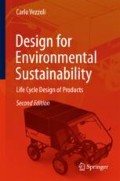Abstract
Design choices should be aimed at resources (materials and energy sources) with lower impact, while offering equal terms of service or functional unit with the life cycle of a product.
Access this chapter
Tax calculation will be finalised at checkout
Purchases are for personal use only
Notes
- 1.
Generally, rail transport should be preferred to other land transport or air transportation.
- 2.
To read the complete list, cf. the www.euresp-plus.net/it/node/574 website.
- 3.
The figures refer to the production of 1 kg of each material, and are linked to the impact on human health in terms of toxicity and harmfulness. The evaluation is carried out through the LCA, and, in particular, the adopted methodology is the ReCiPe, elaborated by the CML Center of the Leiden University, by PRé Consultant and by the Radboud Universiteit in Nijmegen. For further details about the ReCiPe method, cf. Chap. 14, Part III.
- 4.
Cf. Chap. 8 of this Part.
- 5.
Composite materials normally have a high impact during production and are not easily recyclable. Anyhow, given the lightness and resistance they might have, they are indispensable materials for vehicles due to the reduction in energy consumption.
- 6.
The non-use of materials or, more correctly, the minimization of their use was defined in Chap. 4 of this Part.
- 7.
Polymers are often complemented by additives against heat, fire and ultraviolet rays, with reinforcing, filling, weighing, expanding and antioxidant additives.
- 8.
Cf. Chap. 8 of this Part.
- 9.
To be precise, muscular energy is powered by our nutrition. And producing comestibles is not impact-free. To be even more precise, this impact depends on the type of food and its production characteristics. In sum, we can claim that a 5-km race after eating biological food has a smaller impact than after eating food that has been procured with traditional cultivation, including using pesticides, eutrophication agents and surplus irrigation.
Author information
Authors and Affiliations
Corresponding author
Rights and permissions
Copyright information
© 2018 Springer-Verlag London Ltd., part of Springer Nature
About this chapter
Cite this chapter
Vezzoli, C. (2018). Minimising Resources Toxicity and Harmfulness. In: Design for Environmental Sustainability. Springer, London. https://doi.org/10.1007/978-1-4471-7364-9_6
Download citation
DOI: https://doi.org/10.1007/978-1-4471-7364-9_6
Published:
Publisher Name: Springer, London
Print ISBN: 978-1-4471-7363-2
Online ISBN: 978-1-4471-7364-9
eBook Packages: EngineeringEngineering (R0)

